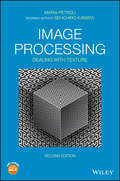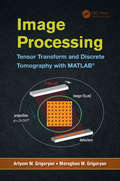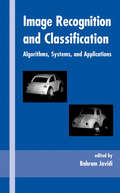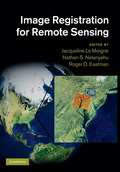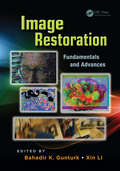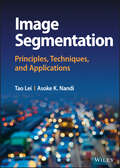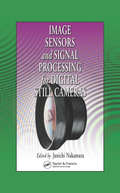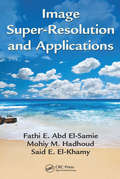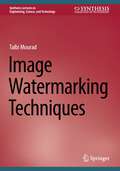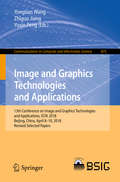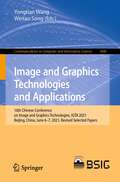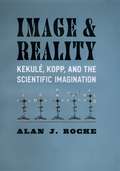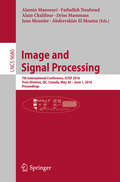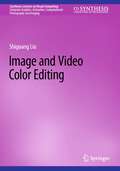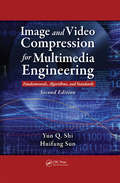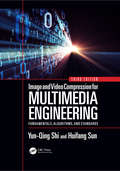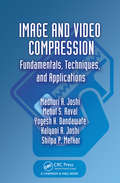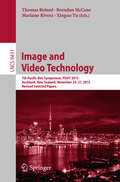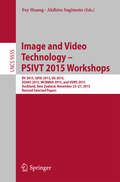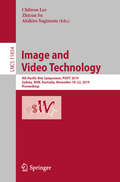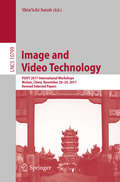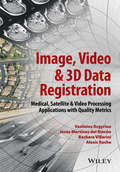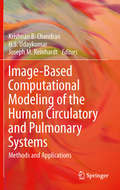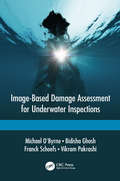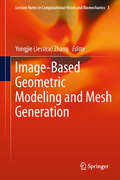- Table View
- List View
Image Processing: Dealing with Texture
by Maria M. Petrou Sei-ichiro KamataThe classic text that covers practical image processing methods and theory for image texture analysis, updated second edition The revised second edition of Image Processing: Dealing with Textures updates the classic work on texture analysis theory and methods without abandoning the foundational essentials of this landmark work. Like the first, the new edition offers an analysis of texture in digital images that are essential to a diverse range of applications such as: robotics, defense, medicine and the geo-sciences. Designed to easily locate information on specific problems, the text is structured around a series of helpful questions and answers. Updated to include the most recent developments in the field, many chapters have been completely revised including: Fractals and Multifractals, Image Statistics, Texture Repair, Local Phase Features, Dual Tree Complex Wavelet Transform, Ridgelets and Curvelets and Deep Texture Features. The book takes a two-level mathematical approach: light math is covered in the main level of the book, with harder math identified in separate boxes. This important text: Contains an update of the classic advanced text that reviews practical image processing methods and theory for image texture analysis Puts the focus exclusively on an in-depth exploration of texture Contains a companion website with exercises and algorithms Includes examples that are fully worked to enhance the learning experience Written for students and researchers of image processing, the second edition of Image Processing has been revised and updated to incorporate the foundational information on the topic and information on the latest advances.
Image Processing: Tensor Transform and Discrete Tomography with MATLAB ®
by Artyom M. Grigoryan Merughan M. GrigoryanFocusing on mathematical methods in computer tomography, Image Processing: Tensor Transform and Discrete Tomography with MATLAB® introduces novel approaches to help in solving the problem of image reconstruction on the Cartesian lattice. Specifically, it discusses methods of image processing along parallel rays to more quickly and accurately reconstruct images from a finite number of projections, thereby avoiding overradiation of the body during a computed tomography (CT) scan. The book presents several new ideas, concepts, and methods, many of which have not been published elsewhere. New concepts include methods of transferring the geometry of rays from the plane to the Cartesian lattice, the point map of projections, the particle and its field function, and the statistical model of averaging. The authors supply numerous examples, MATLAB®-based programs, end-of-chapter problems, and experimental results of implementation. The main approach for image reconstruction proposed by the authors differs from existing methods of back-projection, iterative reconstruction, and Fourier and Radon filtering. In this book, the authors explain how to process each projection by a system of linear equations, or linear convolutions, to calculate the corresponding part of the 2-D tensor or paired transform of the discrete image. They then describe how to calculate the inverse transform to obtain the reconstruction. The proposed models for image reconstruction from projections are simple and result in more accurate reconstructions. Introducing a new theory and methods of image reconstruction, this book provides a solid grounding for those interested in further research and in obtaining new results. It encourages readers to develop effective applications of these methods in CT.
Image Recognition and Classification: Algorithms, Systems, and Applications (Optical Science and Engineering)
by Bahram Javidi"Details the latest image processing algorithms and imaging systems for image recognition with diverse applications to the military; the transportation, aerospace, information security, and biomedical industries; radar systems; and image tracking systems."
Image Registration for Remote Sensing
by Jacqueline Le Moigne Nathan S. Netanyahu Roger D. EastmanImage registration employs digital image processing in order to bring two or more digital images into precise alignment for analysis and comparison. Accurate registration algorithms are essential for creating mosaics of satellite images and tracking changes on the planet's surface over time. Bringing together invited contributions from 36 distinguished researchers, the book presents a detailed overview of current research and practice in the application of image registration to remote sensing imagery. Chapters cover the problem definition, theoretical issues in accuracy and efficiency, fundamental algorithms, and real-world case studies of image registration software applied to imagery from operational satellite systems. This book provides a comprehensive and practical overview for Earth and space scientists, presents image processing researchers with a summary of current research, and can be used for specialised graduate courses.
Image Restoration: Fundamentals and Advances (Digital Imaging and Computer Vision #7)
by Xin Li Bahadir K. GunturkImage Restoration: Fundamentals and Advances responds to the need to update most existing references on the subject, many of which were published decades ago. Providing a broad overview of image restoration, this book explores breakthroughs in related algorithm development and their role in supporting real-world applications associated with various scientific and engineering fields. These include astronomical imaging, photo editing, and medical imaging, to name just a few. The book examines how such advances can also lead to novel insights into the fundamental properties of image sources. Addressing the many advances in imaging, computing, and communications technologies, this reference strikes just the right balance of coverage between core fundamental principles and the latest developments in this area. Its content was designed based on the idea that the reproducibility of published works on algorithms makes it easier for researchers to build on each other’s work, which often benefits the vitality of the technical community as a whole. For that reason, this book is as experimentally reproducible as possible. Topics covered include: Image denoising and deblurring Different image restoration methods and recent advances such as nonlocality and sparsity Blind restoration under space-varying blur Super-resolution restoration Learning-based methods Multi-spectral and color image restoration New possibilities using hybrid imaging systems Many existing references are scattered throughout the literature, and there is a significant gap between the cutting edge in image restoration and what we can learn from standard image processing textbooks. To fill that need but avoid a rehash of the many fine existing books on this subject, this reference focuses on algorithms rather than theories or applications. Giving readers access to a large amount of downloadable source code, the book illustrates fundamental techniques, key ideas developed over the years, and the state of the art in image restoration. It is a valuable resource for readers at all levels of understanding.
Image Segmentation: Principles, Techniques, and Applications
by Asoke K. Nandi Tao LeiImage Segmentation Summarizes and improves new theory, methods, and applications of current image segmentation approaches, written by leaders in the field The process of image segmentation divides an image into different regions based on the characteristics of pixels, resulting in a simplified image that can be more efficiently analyzed. Image segmentation has wide applications in numerous fields ranging from industry detection and bio-medicine to intelligent transportation and architecture. Image Segmentation: Principles, Techniques, and Applications is an up-to-date collection of recent techniques and methods devoted to the field of computer vision. Covering fundamental concepts, new theories and approaches, and a variety of practical applications including medical imaging, remote sensing, fuzzy clustering, and watershed transform. In-depth chapters present innovative methods developed by the authors—such as convolutional neural networks, graph convolutional networks, deformable convolution, and model compression—to assist graduate students and researchers apply and improve image segmentation in their work. Describes basic principles of image segmentation and related mathematical methods such as clustering, neural networks, and mathematical morphology. Introduces new methods for achieving rapid and accurate image segmentation based on classic image processing and machine learning theory. Presents techniques for improved convolutional neural networks for scene segmentation, object recognition, and change detection, etc. Highlights the effect of image segmentation in various application scenarios such as traffic image analysis, medical image analysis, remote sensing applications, and material analysis, etc. Image Segmentation: Principles, Techniques, and Applications is an essential resource for undergraduate and graduate courses such as image and video processing, computer vision, and digital signal processing, as well as researchers working in computer vision and image analysis looking to improve their techniques and methods.
Image Sensors and Signal Processing for Digital Still Cameras (Optical Science and Engineering)
by Junichi NakamuraShrinking pixel sizes along with improvements in image sensors, optics, and electronics have elevated DSCs to levels of performance that match, and have the potential to surpass, that of silver-halide film cameras. Image Sensors and Signal Processing for Digital Still Cameras captures the current state of DSC image acquisition and signal processing technology and takes an all-inclusive look at the field, from the history of DSCs to future possibilities.The first chapter outlines the evolution of DSCs, their basic structure, and their major application classes. The next few chapters discuss high-quality optics that meet the requirements of better image sensors, the basic functions and performance parameters of image sensors, and detailed discussions of both CCD and CMOS image sensors. The book then discusses how color theory affects the uses of DSCs, presents basic image processing and camera control algorithms and examples of advanced image processing algorithms, explores the architecture and required performance of signal processing engines, and explains how to evaluate image quality for each component described. The book closes with a look at future technologies and the challenges that must be overcome to realize them.With contributions from many active DSC experts, Image Sensors and Image Processing for Digital Still Cameras offers unparalleled real-world coverage and opens wide the door for future innovation.
Image Super-Resolution and Applications
by Fathi E. El-Samie Mohiy M. Hadhoud Said E. El-KhamyThis book is devoted to the issue of image super-resolution-obtaining high-resolution images from single or multiple low-resolution images. Although there are numerous algorithms available for image interpolation and super-resolution, there's been a need for a book that establishes a common thread between the two processes. Filling this need, Image
Image Watermarking Techniques (Synthesis Lectures on Engineering, Science, and Technology)
by Talbi MouradThis book investigates the image watermarking domain, analyzing and comparing image watermarking techniques that exist in current literature. The author’s goal is to aid researchers and students in their studies in the vast and important domain of image watermarking, including its advantages and risks. The book has three chapters: image watermarking using data compression; speech modulation for image watermarking; and secure image watermarking based on LWT and SVD.In addition, this book: Investigates the image watermarking domain, analyzing and comparing current image watermarking techniquesIncludes detail on image encryption and mathematical tools used for image watermarkingCovers image watermarking using data compression, speech modulation for image watermarking, and more
Image and Graphics Technologies and Applications: 13th Conference On Image And Graphics Technologies And Applications, Igta 2018, Beijing, China, April 8-10, 2018, Revised Selected Papers (Communications In Computer And Information Science #875)
by Yongtian Wang Zhiguo Jiang Yuxin PengThis book constitutes the refereed proceedings of the 13th Chinese Conference on Image and Graphics Technologies and Applications, IGTA 2018, held in Beijing, China in April, 2018. The 64 papers presented were carefully reviewed and selected from 138 submissions. They provide a forum for sharing progresses in the areas of image processing technology; image analysis and understanding; computer vision and pattern recognition; big data mining, computer graphics and VR; as well as image technology applications.
Image and Graphics Technologies and Applications: 16th Chinese Conference on Image and Graphics Technologies, IGTA 2021, Beijing, China, June 6–7, 2021, Revised Selected Papers (Communications in Computer and Information Science #1480)
by Yongtian Wang Weitao SongThis book constitutes the refereed proceedings of the 16th Conference on Image and Graphics Technologies and Applications, IGTA 2021, held in Beijing, China in June, 2021. The 21 papers presented were carefully reviewed and selected from 86 submissions. They provide a forum for sharing progresses in the areas of image processing technology; image analysis and understanding; computer vision and pattern recognition; big data mining, computer graphics and VR, as well as image technology applications. The volume contains the following thematic blocks: image processing and enhancement techniques (image information acquisition, image/video coding, image/video transmission, image/video storage, compression, completion, dehazing, reconstruction and display, etc.); biometric identification techniques (biometric identification and authentication techniques including face, fingerprint, iris and palm-print, etc.); machine vision and 3D reconstruction (visual information acquisition, camera calibration, stereo vision, 3D reconstruction, and applications of machine vision in industrial inspection, etc.); image/video big data analysis and understanding (object detection and recognition, image/video retrieval, image segmentation, matching, analysis and understanding); computer graphics (modeling, rendering, algorithm simplification and acceleration techniques, realistic scene generation, 3D reconstruction algorithm, system and application, etc.); virtual reality and human-computer interaction (virtual scene generation techniques, tracing and positioning techniques for large-scale space, augmented reality techniques, human-computer interaction techniques based on computer vision, etc.); applications of image and graphics (image/video processing and transmission, biomedical engineering applications, information security, digital watermarking, text processing and transmission, remote sensing, telemetering, etc.); other research works and surveys related to the applications of image and graphics technology.
Image and Reality: Kekule, Kopp, and the Scientific Imagination
by Alan J. RockeNineteenth-century chemists were faced with a particular problem: how to depict the atoms and molecules that are beyond the direct reach of our bodily senses. In visualizing this microworld, these scientists were the first to move beyond high-level philosophical speculations regarding the unseen. In Image and Reality, Alan Rocke focuses on the community of organic chemists in Germany to provide the basis for a fuller understanding of the nature of scientific creativity. Arguing that visual mental images regularly assisted many of these scientists in thinking through old problems and new possibilities, Rocke uses a variety of sources, including private correspondence, diagrams and illustrations, scientific papers, and public statements, to investigate their ability to not only imagine the invisibly tiny atoms and molecules upon which they operated daily, but to build detailed and empirically based pictures of how all of the atoms in complicated molecules were interconnected. These portrayals of “chemical structures,” both as mental images and as paper tools, gradually became an accepted part of science during these years and are now regarded as one of the central defining features of chemistry. In telling this fascinating story in a manner accessible to the lay reader, Rocke also suggests that imagistic thinking is often at the heart of creative thinking in all fields. Image and Reality is the first book in the Synthesis series, a series in the history of chemistry, broadly construed, edited by Angela N. H. Creager, John E. Lesch, Stuart W. Leslie, Lawrence M. Principe, Alan Rocke, E. C. Spary, and Audra J. Wolfe, in partnership with the Chemical Heritage Foundation.
Image and Signal Processing
by Alamin Mansouri Fathallah Nouboud Alain Chalifour Driss Mammass Jean Meunier Abderrahim ElmoatazThis book constitutes the refereed proceedings of the 7th International Conference, ICISP 2016, held in May/June 2016 in Trois-Rivières, QC, Canada. The 40 revised full papers were carefully reviewed and selected from 83 submissions. The contributions are organized in topical sections on features extraction, computer vision, and pattern recognition; multispectral and color imaging; image filtering, segmentation, and super-resolution; signal processing; biomedical imaging; geoscience and remote sensing; watermarking, authentication and coding; and 3d acquisition, processing, and applications.
Image and Video Color Editing (Synthesis Lectures on Visual Computing: Computer Graphics, Animation, Computational Photography and Imaging)
by Shiguang LiuThis book covers image and video color editing research advances over the last two decades. Bringing readers up to speed on digital image and video editing techniques and research, the book delves into an area that has attracted much attention from researchers due to the rapid development of computer graphics and the widespread prevalence of digital cameras and mobile phones in daily life. Readers will get a comprehensive overview of the theory and application of color transfer, emotional color transfer, colorization, decolorization, and style transfer in altering still and moving digital images. Despite the existence of professional image editing software that can complete complex image editing work, the skills required to achieve satisfactory editing results can be prohibitive, and even professional image editors need to spend a lot of time developing and maintaining aptitude in a niche tool. Instead, the book explores image and video editing techniques that are simple and effective alternatives to such editing software that professional and amateur image editors can utilize. The book focuses on color as one of the most important features of an image or video. Image and video color editing aims to dramatically alter source images suitable for a wide range of applications.
Image and Video Compression for Multimedia Engineering: Fundamentals, Algorithms, and Standards (Second Edition) (Image Processing Series)
by Yun Q. Shi Huifang Sun<p>Multimedia hardware still cannot accommodate the demand for large amounts of visual data. Without the generation of high-quality video bitstreams, limited hardware capabilities will continue to stifle the advancement of multimedia technologies. Thorough grounding in coding is needed so that applications such as MPEG-4 and JPEG 2000 may come to fruition. <p>Image and Video Compression for Multimedia Engineering provides a solid, comprehensive understanding of the fundamentals and algorithms that lead to the creation of new methods for generating high quality video bit streams. The authors present a number of relevant advances along with international standards. <p>Visual data, image, and video coding will continue to enable the creation of advanced hardware, suitable to the demands of new applications. Covering both image and video compression, this book yields a unique, self-contained reference for practitioners tobuild a basis for future study, research, and development.</p>
Image and Video Compression for Multimedia Engineering: Fundamentals, Algorithms, and Standards, Third Edition (Image Processing Series)
by Yun-Qing Shi Huifang SunThe latest edition provides a comprehensive foundation for image and video compression. It covers HEVC/H.265 and future video coding activities, in addition to Internet Video Coding. The book features updated chapters and content, along with several new chapters and sections. It adheres to the current international standards, including the JPEG standard.
Image and Video Compression: Fundamentals, Techniques, and Applications
by Madhuri A. Joshi Mehul S. Raval Yogesh H. Dandawate Kalyani R. Joshi Shilpa P. MetkarImage and video signals require large transmission bandwidth and storage, leading to high costs. The data must be compressed without a loss or with a small loss of quality. Thus, efficient image and video compression algorithms play a significant role in the storage and transmission of data.Image and Video Compression: Fundamentals, Techniques, and
Image and Video Technology
by Mariano Rivera Thomas Bräunl Brendan Mccane Xinguo YuThisbook constitutes the thoroughly refereed post-conference proceedings of the 7thPacific Rim Symposium on Image and Video Technology, PSIVT 2015, held in Auckland,New Zealand, in November 2015. Thetotal of 61 revised papers was carefully reviewed and selected from 133submissions. The papers are organized in topical sections on color and motion,image/video coding and transmission, computational photography and arts, computervision and applications, image segmentation and classification, videosurveillance, biomedical image processing and analysis, object and patternrecognition, computer vision and pattern recognition, image/video processingand analysis, and pattern recognition.
Image and Video Technology - PSIVT 2015 Workshops
by Fay Huang Akihiro SugimotoThis book constitutes the thoroughly refereedpost-conference proceedings of six international workshops held in theframework of the 7th Pacific-Rim Symposium on Image and Video Technology, PSIVT2015, during November 23-24, 2015, in Auckland, New Zealand. The 29 revised full papers presented werecarefully selected from 58 submissions. Their topics diversely ranged fromwell-established areas to novel current trends: robot vision, RV 2015; 2D and3D geometric properties from incomplete data, GPID 2015; vision meets graphics,VG 2015; passive and active electro-optical sensors for aerial and spaceimaging, EO4AS 2015; mathematical and computational methods in biomedicalimaging and image analysis, MCBMIIA 2015; and video surveillance, VSWS 2015.
Image and Video Technology: 9th Pacific-Rim Symposium, PSIVT 2019, Sydney, NSW, Australia, November 18–22, 2019, Proceedings (Lecture Notes in Computer Science #11854)
by Zhixun Su Akihiro Sugimoto Chilwoo LeeThis book constitutes the conference proceedings of the 9th Pacific Rim Symposium on Image and Video Technology, PSIVT 2019, held in Sydney, NSW, Australia, in November 2019. A total of 31 papers were carefully reviewed and selected from 55 submissions. The main conference comprises 11 major subject areas that span the field of image and video technology, namely imaging and graphics hardware and visualization, image/video coding and transmission, image/video processing and analysis, image/video retrieval and scene understanding, applications of image and video technology, biomedical image processing and analysis, biometrics and image forensics, computational photography and arts, computer and robot vision, pattern recognition, and video surveillance.
Image and Video Technology: PSIVT 2017 International Workshops, Wuhan, China, November 20-24, 2017, Revised Selected Papers (Lecture Notes in Computer Science #10799)
by Shin'Ichi SatohThis book constitutes the thoroughly refereed post-conference proceedings of five international workshops held in the framework of the 8th Pacific-Rim Symposium on Image and Video Technology, PSIVT 2017, in Wuhan, China, in November 2017: Workshop on Human Behavior Analysis; Workshop on Educational Cloud and Image/Video Enriched Cloud Services, ECIVECS; Workshop: Vision Meets Graphics, VG; Workshop on Active Electro-Optical Sensors for Aerial and Space Imaging, EO4AS; and Workshop on Computer Vision and Modern Vehicles, CVMV.The 34 revised full papers and 2 posters presented were carefully selected from 103 submissions. The papers cover the full range of state-of-the-art research in image and video technology with topics ranging from well-established areas to novel current trends.
Image, Video and 3D Data Registration
by Jesus Martinez Del Rincon Barbara Villarini Vasileios Argyriou Alexis RocheData registration refers to a series of techniques for matching or bringing similar objects or datasets together into alignment. These techniques enjoy widespread use in a diverse variety of applications, such as video coding, tracking, object and face detection and recognition, surveillance and satellite imaging, medical image analysis and structure from motion. Registration methods are as numerous as their manifold uses, from pixel level and block or feature based methods to Fourier domain methods. This book is focused on providing algorithms and image and video techniques for registration and quality performance metrics. The authors provide various assessment metrics for measuring registration quality alongside analyses of registration techniques, introducing and explaining both familiar and state-of-the-art registration methodologies used in a variety of targeted applications.Key features: Provides a state-of-the-art review of image and video registration techniques, allowing readers to develop an understanding of how well the techniques perform by using specific quality assessment criteria Addresses a range of applications from familiar image and video processing domains to satellite and medical imaging among others, enabling readers to discover novel methodologies with utility in their own research Discusses quality evaluation metrics for each application domain with an interdisciplinary approach from different research perspectives
Image-Based Computational Modeling of the Human Circulatory and Pulmonary Systems
by Krishnan B. Chandran Joseph M. Reinhardt H. S. UdaykumarImage-Based Computational Modeling of the Human Circulatory and Pulmonary Systems provides an overview of the current modeling methods and applications enhancing interventional treatments and computer-aided surgery. A detailed description of the techniques behind image acquisition, processing and three-dimensional reconstruction are included. Techniques for the computational simulation of solid and fluid mechanics and structure interaction are also discussed, in addition to various cardiovascular and pulmonary applications. Engineers and researchers involved with image processing and computational modeling of human organ systems will find this a valuable reference.
Image-Based Damage Assessment for Underwater Inspections
by Franck Schoefs Michael O’Byrne Bidisha Ghosh Vikram PakrashiInspection is crucial to the management of ageing infrastructure. Visual information on structures is regularly collected but very little work exists on its organised and quantitative analysis, even though image processing can significantly enhance these inspection processes and transfer real financial and safety benefits to the managers, owners and users. Additionally, new opportunities exist in the fast evolving sectors of wind and wave energy to add value to image-based inspection techniques. <P><P>This book is a first for structural engineers and inspectors who wish to harness the full potential of cameras as an inspection tool. It is particularly directed to the inspection of offshore and marine structures and the application of image-based methods in underwater inspections. It outlines a set of best practice guidelines for obtaining imagery, then the fundamentals of image processing are covered along with several image processing techniques which can be used to assess multiple damage forms: crack detection, corrosion detection, and depth analysis of marine growth on offshore structures. The book provides benchmark performance measures for these techniques under various visibility conditions using an image repository which will help inspectors to envisage the effectiveness of the techniques when applied. MATLAB® scripts and access to the underwater image repository are included so readers can run these techniques themselves. <P><P>Practising engineers and managers of infrastructure assets are guided in image processing based inspection. Researchers can use this book as a primer, and it also suits advanced graduate courses in infrastructure management or on applied image processing.
Image-Based Geometric Modeling and Mesh Generation
by Yongjie Jessica ZhangAs a new interdisciplinary research area, "image-based geometric modeling and mesh generation" integrates image processing, geometric modeling and mesh generation with finite element method (FEM) to solve problems in computational biomedicine, materials sciences and engineering. It is well known that FEM is currently well-developed and efficient, but mesh generation for complex geometries (e.g., the human body) still takes about 80% of the total analysis time and is the major obstacle to reduce the total computation time. It is mainly because none of the traditional approaches is sufficient to effectively construct finite element meshes for arbitrarily complicated domains, and generally a great deal of manual interaction is involved in mesh generation. This contributed volume, the first for such an interdisciplinary topic, collects the latest research by experts in this area. These papers cover a broad range of topics, including medical imaging, image alignment and segmentation, image-to-mesh conversion, quality improvement, mesh warping, heterogeneous materials, biomodelcular modeling and simulation, as well as medical and engineering applications. This contributed volume, the first for such an interdisciplinary topic, collects the latest research by experts in this area. These papers cover a broad range of topics, including medical imaging, image alignment and segmentation, image-to-mesh conversion, quality improvement, mesh warping, heterogeneous materials, biomodelcular modeling and simulation, as well as medical and engineering applications. This contributed volume, the first for such an interdisciplinary topic, collects the latest research by experts in this area. These papers cover a broad range of topics, including medical imaging, image alignment and segmentation, image-to-mesh conversion, quality improvement, mesh warping, heterogeneous materials, biomodelcular modeling and simulation, as well as medical and engineering applications. This contributed volume, the first for such an interdisciplinary topic, collects the latest research by experts in this area. These papers cover a broad range of topics, including medical imaging, image alignment and segmentation, image-to-mesh conversion, quality improvement, mesh warping, heterogeneous materials, biomodelcular modeling and simulation, as well as medical and engineering applications.
